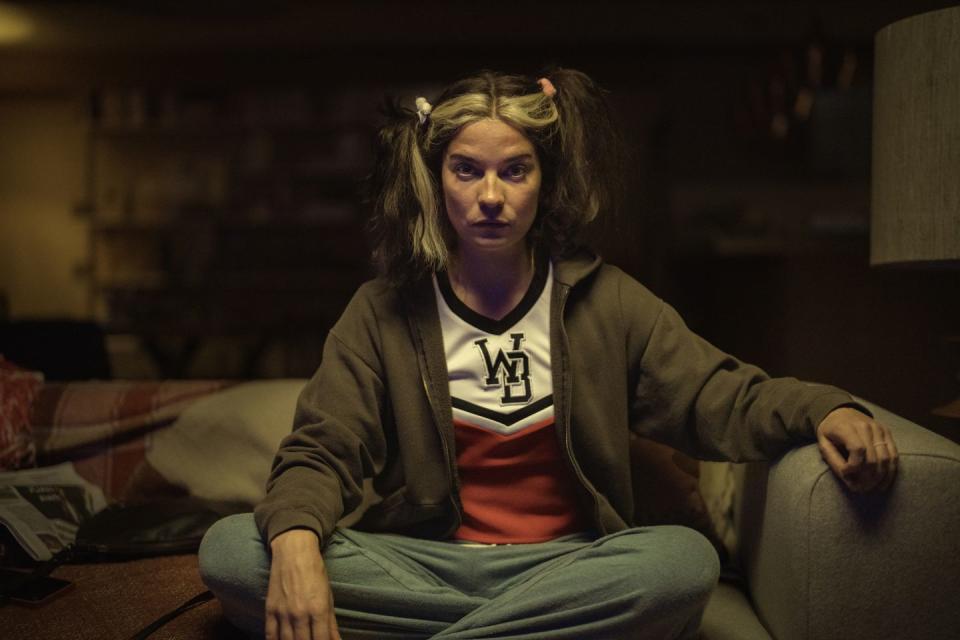The 4 Best New 'Black Mirror' Theories the Internet Can Muster Up

- Oops!Something went wrong.Please try again later.
The long awaited sixth season of Black Mirror is officially here, with new episodes starring the likes of Schitt’s Creek’s Annie Murphy, Aaron Paul, Salma Hayek, Kate Mara, and Zazie Beetz, among others. The season ends a long hiatus for the series, with new Black Mirror episodes skewering streaming services, fame, and of course technology.
Ever mind-bending and terrifyingly predictive, Black Mirror fans are already filling Reddit threads and hashtags with theories. Let’s crack some of our favorites open.
Warning, major spoilers for 'Black Mirror' ahead!
Theory #1: "Joan Is Awful" Was Inspired by Elizabeth Holmes
This season 6 theory was all but confirmed by Black Mirror creator's, Charlie Brooker. He spoke to Metro, saying the season 6 premiere episode was inspired by his own viewing of the Hulu hit, The Dropout. He was taken in by the idea that the case of Theranos and Elizabeth Holmes had happened so recently, and yet had already been flipped into a dramatic series.

If you’ve watched “Joan Is Awful,” then you’ll see the connection here. In the episode, a regular woman finds her life adapted into a series from a top streamer, dramatizing experiences in her life mere moments after they happen. That fictional streamer– “Streamberry,” in the Black Mirror universe–also confirmed a long suspected fan theory: that every episode of Black Mirror exists in the same universe. Which we should discuss....
Theory #2: All 6 Seasons of Black Mirror Share One Universe
As Joan, from the titular “Joan Is Awful,” sits on the couch with her fiancé looking for something to watch on Streamberry, they flip through options including“Loch Henry,” which happens to be the second episode in Black Mirror season 6, and “The Callow Years,” a fictional docuseries detailing the prime ministership of Michael Callow, the subject of the first ever episode of Black Mirror episode, “The National Anthem.” In fact, every title that appears on Joan’s Streamberry account is a callback to a previous episode, from “San Junipero” to “15 Million Merits.” This quick moment, easy to miss and seemingly insignificant, spoke to this interconnectedness theory that has held 6 seasons strong.
Further proof includes the season 4 finale episode, “Black Museum,” which offered the first clue of a shared universe. The episode follows a visitor of a museum home to creepy exhibits that call back to Black Mirror’s previous 18 episodes. It is, in the same breath, a tribute to the series and a confirmation of the singularity.
Theory #3: Technology Has Heeded the Commercialization of Prison
In truth, prison is already commercialized. In Black Mirror's many versions of the future, it's just more consumer driven, tangible, and truly inhumane. The most obvious iteration of this concept appears in the season 2 episode “White Bear,” but other echoes of it appear elsewhere, leading fans to speculate.
In season 1's “15 Million Merits,” for example, a future is introduced in which citizens must exercise on stationary bikes to earn currency, surrounded by screens and blue light. On the face of it, the episode is a commentary on capitalism, but fans have dug deeper, with many theorizing the episode reveals a futuristic form of prison. One Redditor’s theory reads, “The events of ‘15 Million Merits’ take place in a prison set in the very near future. A new type of prison system allows for inmates to generate electricity and use their imaginary currency to distract themselves from their situation.”
The most supportive evidence comes in the form of the episode’s characters, all of whom clean, entertain, and generate electricity. This incomplete vision of society is barren of doctors, engineers, scientists, teachers, and other careers that help uphold infrastructure. Beyond that, the episode’s dialogue implies that the cyclers have not always been there; there was a life before this futuristic prison.
Theory #4: The Digital Afterlife Is Upon Us...and Comes With a Warning
While many experts today are warning against the dangers of AI, much of Black Mirror’s humanity has already been corrupted by highly advanced digital consciousness. Throughout the series, digital consciousness in the form of “cookies” pops up in episodes like “White Christmas” and expands to create alternate afterlives, also appearing in “San Junipero” and “U.S.S Callister,” causing fans to theorize how these connections may point to a larger message from the series writers.
Black Mirror’s version of humanity is not forgiving, nor is it optimistic, and predictions about ways we can collectively create eternal life (and/or eternal hell) through technology are all too real.
‘Black Mirror’ season 6 is available to stream on Netflix
You Might Also Like

